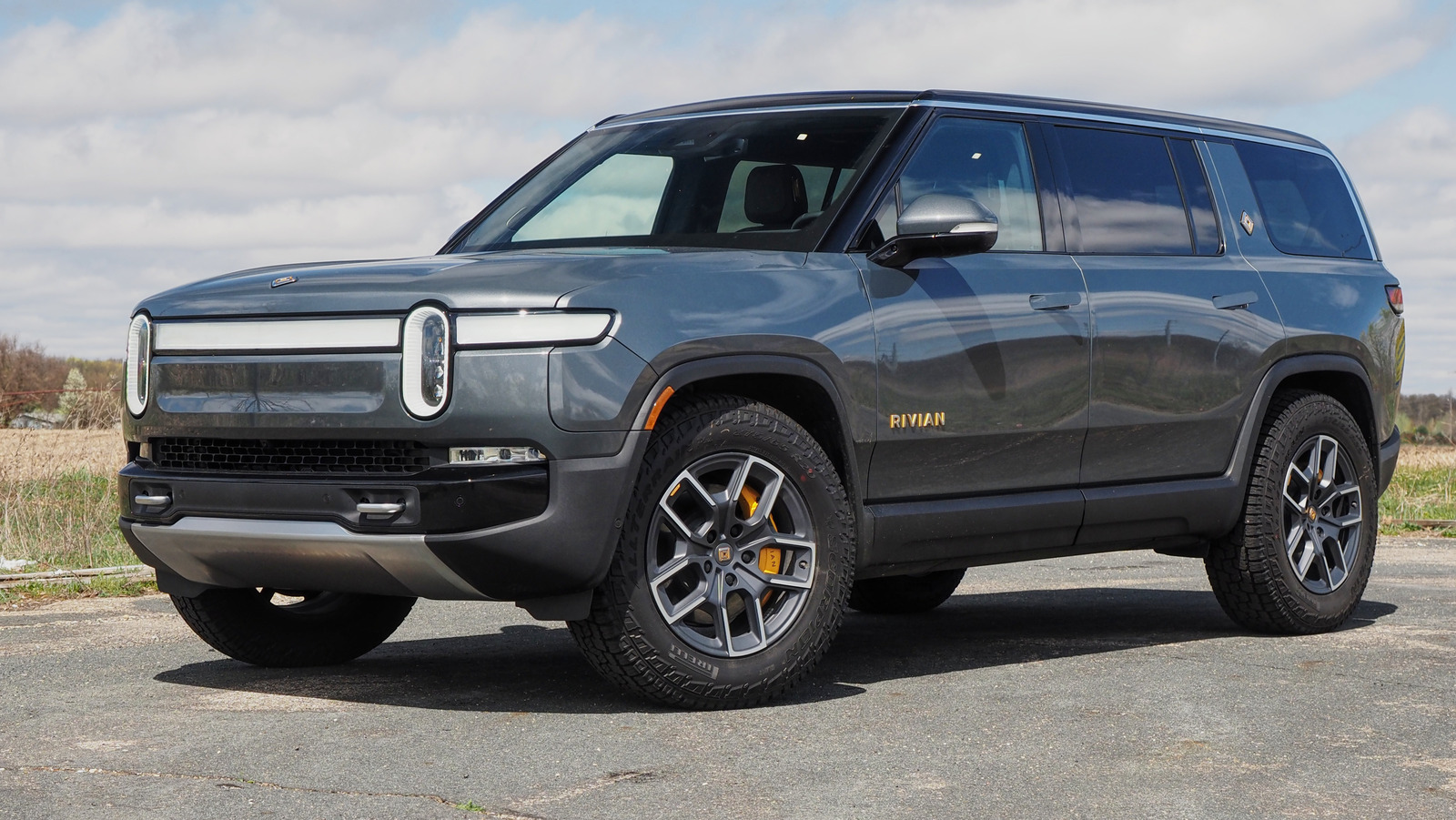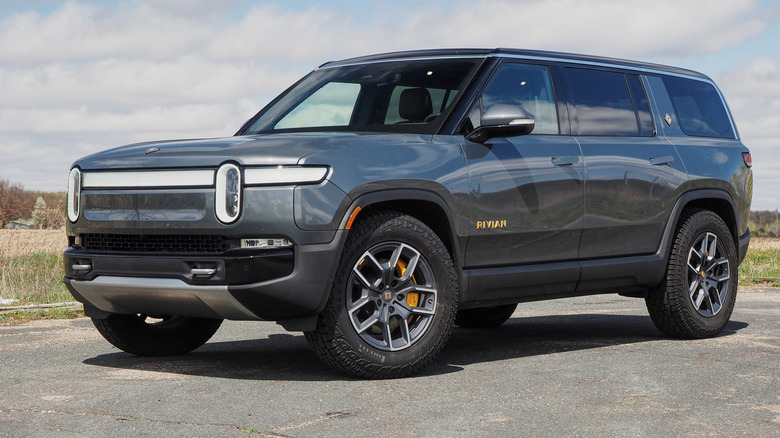
Chris Davies/SlashGear
EDITORS’ RATING : 9 / 10
- Handsome and practical three-row SUV
- Quad-motor AWD is ridiculously fast
- Solid battery life
- Cabin sets a benchmark for EV interiors
- Highway Assist ADAS tech can be glitchy
- No Apple CarPlay or Android Auto
- Expensive in flagship trim
Rivian picked two atypical categories in which to launch its first electric vehicles. As pretty much the first EV pickup to begin deliveries — albeit in small numbers — the R1T capably demonstrated not only what a boon electrification could be to off-road and utility vehicles, but that the automaker itself could live up to its big promises. Following on is the Rivian R1S, a rare electric option in the three-row SUV category.
While Kia will wade into that segment with the EV9 later this year, and Tesla has (fairly snug) three-row configurations of the Model Y and Model X, Rivian’s big EV SUV is an uncompromising way to carry up to seven people. As a result, it makes for a big car overall. While more than a foot shorter than the R1T pickup, the R1S’ 200.8-inch length and 81.8-inch width (with side mirrors folded) still make it a hefty affair.
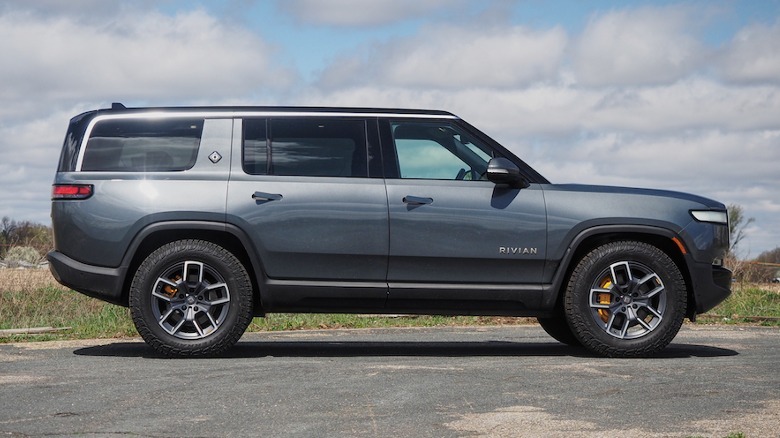 Chris Davies/SlashGear
Chris Davies/SlashGear
The price, too, is considerable. Like with the R1T, the launch configuration gives each of the R1S wheels its own electric motor. The result is a quad-motor AWD and a standard-fit Large battery, with a $92,000 sticker. Compromises on power, range, traction, and an R1S dual-motor AWD with the Standard battery is $78,000. That cheaper model does, though, have the advantage of qualifying (at the time of writing) for $3,750 in federal tax credits, under the U.S. EPA’s latest rules.
A big, distinctive SUV
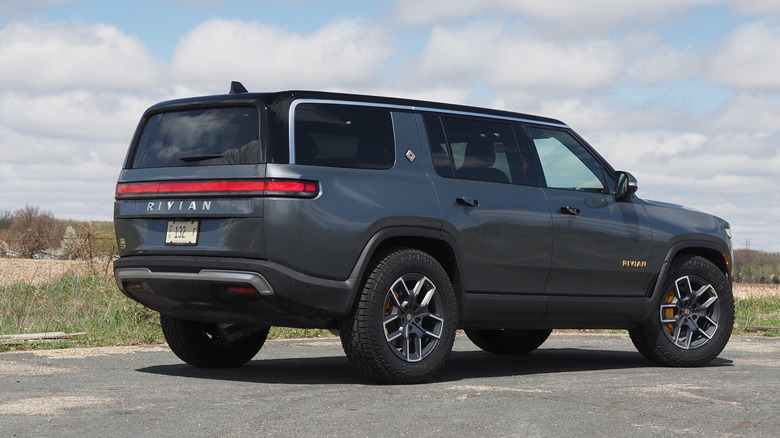
Chris Davies/SlashGear
At a time when aerodynamics feel more important than ever — and new EVs seem to be out-competing each other to have the most slippery silhouette — Rivian’s aesthetic remains charmingly chunky. The upright fascia, with its broad light bar punctuated by fang-like headlamps, is distinctive and memorable. Up to around the B-pillar it’s much as we saw from the R1T, but the R1S truncates the rear overhang and then encloses it.
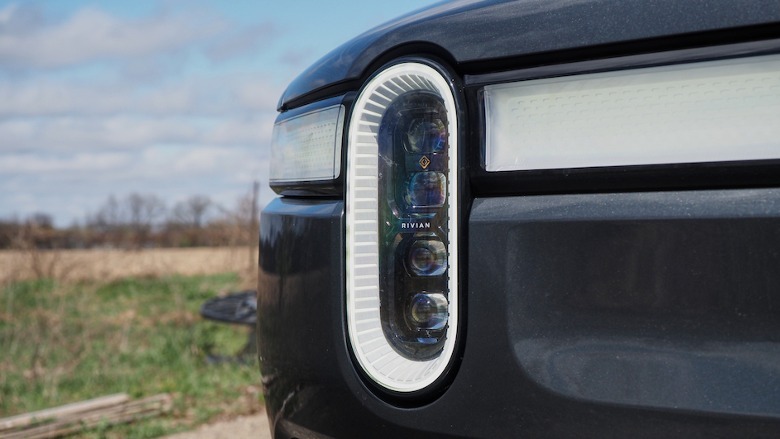 Chris Davies/SlashGear
Chris Davies/SlashGear
It’s practical and helps the third row be adult-scale, but the angles of the black-finish roof at the very rear are perhaps the least successful part of the overall design. It just looks a little top-heavy, from the side view. Saying that, the R1S has a better departure angle than its pickup cousin, at 34.3 degrees versus 30 degrees, and its breakover angle is several degrees improved, too.
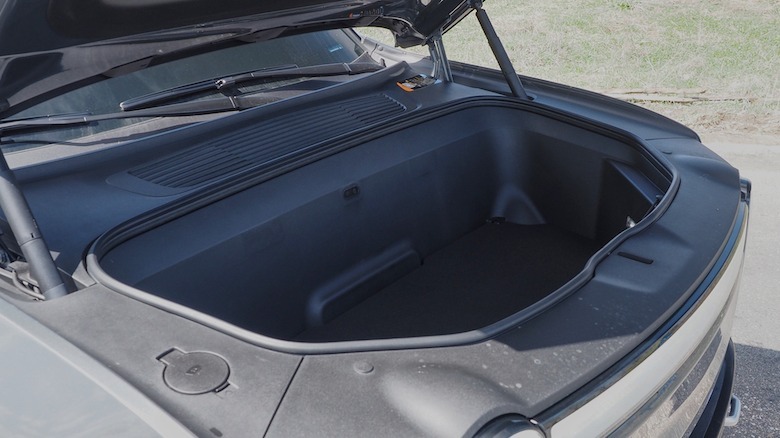 Chris Davies/SlashGear
Chris Davies/SlashGear
That’s not the only practicality on offer, here. The R1S will tow up to 7,700 pounds (albeit down from the 11,000 pounds of the R1T), and with all three rows up there’s a 17.6 cu-ft trunk. Drop the 50/50 split third row, and that expands to 46.7 cu-ft; fold the 40/20/40 middle row, and it swells to a hefty 88.2 cu-ft. There’s 5 cu-ft in a bin under the trunk floor (which can hold a compact spare tire), and 11.1 cu-ft in the front trunk (or frunk) which powers open and closed from the chunky carabiner-styled key fob. Sadly, the body-spanning Gear Tunnel on the R1T is absent.
Touchscreen-first, for better or worse
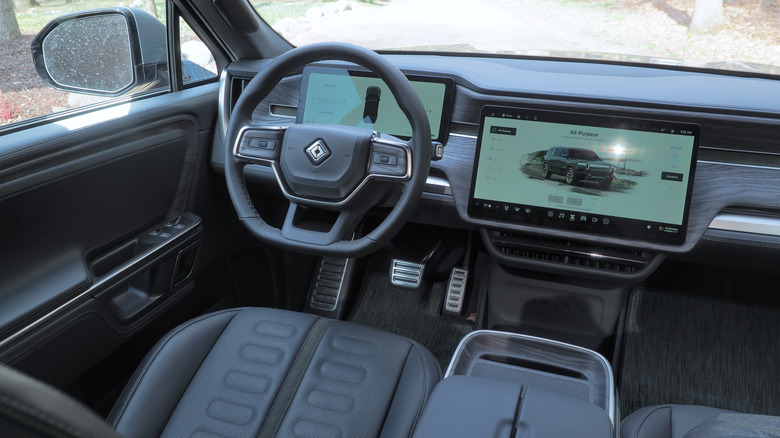
Chris Davies/SlashGear
Inside, Rivian’s cabin sets a new standard for eco-friendly SUVs. It’s a pleasing blend of rugged and comfortable, with soft-but-sturdy vegan leather seat surfaces and slabs of real open-grain wood on the dashboard. What looks like metal actually is metal, too.
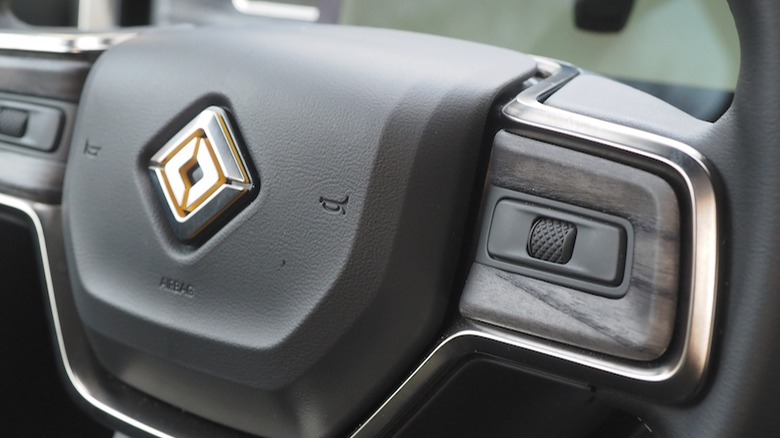 Chris Davies/SlashGear
Chris Davies/SlashGear
Most of your interactions are via Rivian’s 16-inch center touchscreen or the smaller driver display. Physical controls are limited to a stalk on the left of the wheel for lights and wipers, one on the right for gear selection, and two multifunction pads — a button/scroll-wheel flanked by two more buttons — on the wheel spokes. The latter generally handle multimedia and adaptive cruise, though they’re (a little confusingly) unmarked and Rivian relies on them to do other, contextual adjustments too.
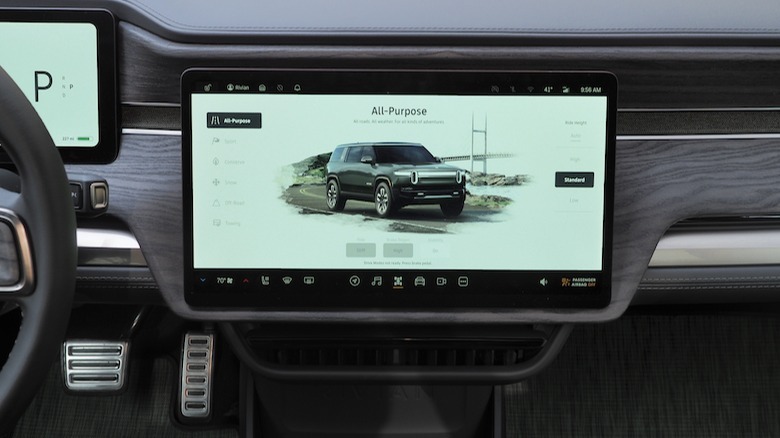 Chris Davies/SlashGear
Chris Davies/SlashGear
For instance, adjusting the steering wheel and side mirror positions is done via the central touchscreen and the wheel controls. You also angle the dashboard air vents via draggable on-screen graphics. I’m not entirely convinced this is more user-friendly than traditional controls.
Neat features galore, and more to come
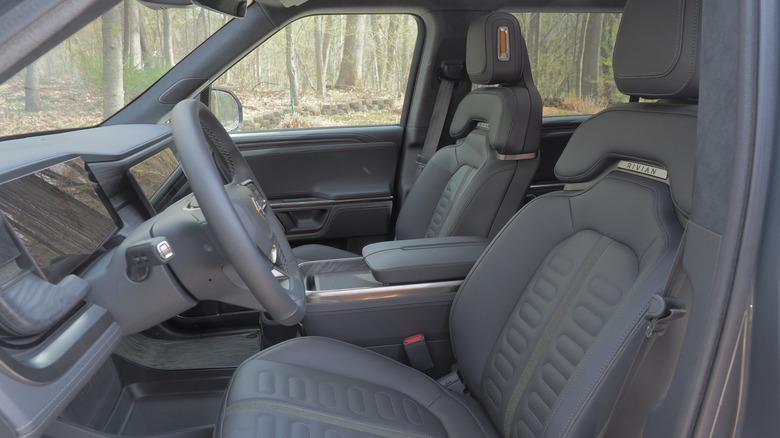
Chris Davies/SlashGear
There are eight USB-C ports spread around the cabin, plus a wireless phone charger pad up-front, and two 120V outlets. That’s solid, though rival large EVs now offer more AC sockets. Vehicle-to-vehicle (V2H) and vehicle-to-home (V2H) support — where the R1S will be able to power other electric vehicles, or even your home in the case of an outage, albeit with equipment yet to be defined — are coming in a future update, the automaker has said.
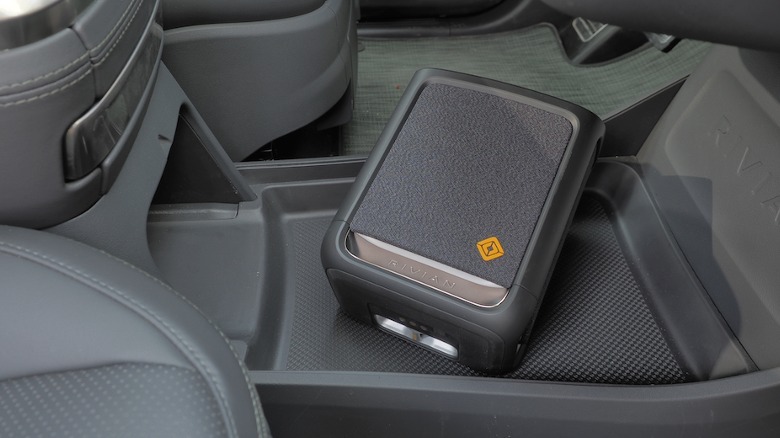 Chris Davies/SlashGear
Chris Davies/SlashGear
For now, the “surprise and delight” is delivered with things like a pull-out Bluetooth speaker that doubles as a camp lantern, and a nifty LED flashlight in the driver’s door. Both recharge from the R1S’s battery when they’re docked in place. The useful built-in air compressor — as handy for inflating beach equipment as it is topping up tires — from the R1T is also standard, here.
Do you want speed or range?
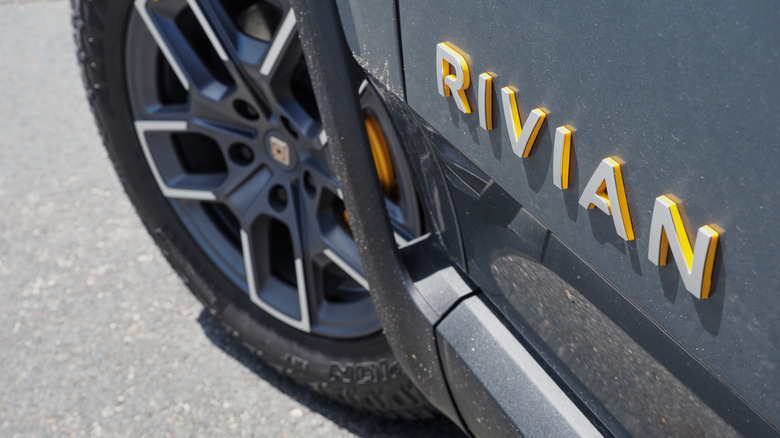
Chris Davies/SlashGear
With four electric motors, it’s no surprise that Rivian’s flagship R1S configuration puts the focus on performance. Altogether there’s 835 horsepower and 908 lb-ft of torque — numbers that would be impressive on a supercar, never mind a family-friendly SUV — and 0-60 mph arrives in just 3.0 seconds. Even the base configuration, with 600 hp and 600 lb-ft, will run from zero to sixty in 4.5 seconds, Rivian promises, while a Performance version of that nudges power up to 700 hp and 700 lb-ft, and cuts a full second from the 0-60 dash.
The downside to the R1S Quad-Motor AWD is range. Even with the bigger battery that Rivian has, it’s rated for 321 miles (other, less potent configurations get up to 390 miles from the same pack). That’s good, for the EV industry at the moment, but it also drops rapidly if you take frequent advantage of the punch on offer.
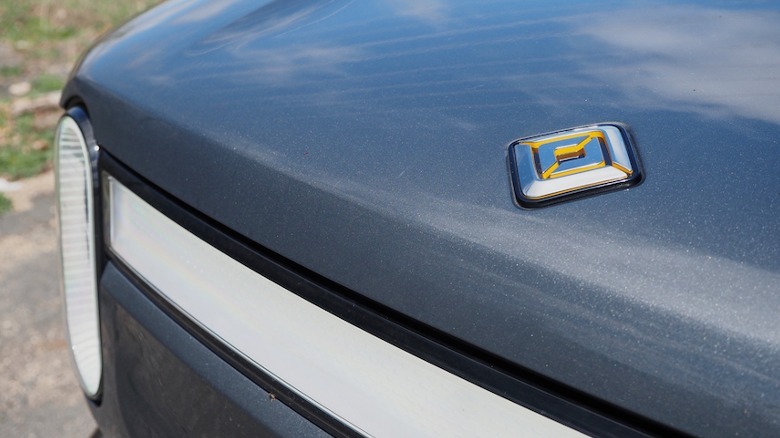 Chris Davies/SlashGear
Chris Davies/SlashGear
The good news is that Rivian’s range estimates seem fairly accurate, even if the navigation system’s prediction of what you’ll end a trip with is noticeably more pessimistic than what the current range displayed might imply. A Conserve mode — which only uses the front motors, and adjusts the standard air suspension to a lower, more frugal position — is the best way to coax as many miles out as possible.
Drive mode and rubber matter
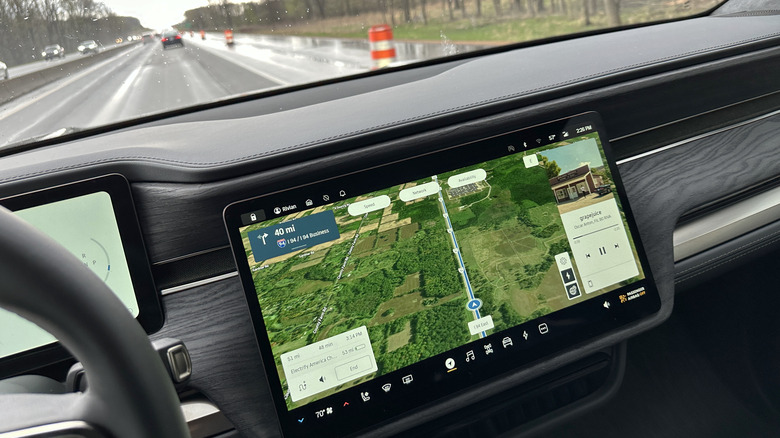
Chris Davies/SlashGear
In a week with several hundred miles of highway driving, for example, the R1S’ dynamic calculations – based on individual driving style, with the car’s 20-inch all-terrain tires — suggested I’d get a maximum 304 miles in Conserve mode, versus 274 miles in the default All-Purpose mode (which activates all four motors). If I’d switched to Sport mode, meanwhile, that would’ve dipped to 270 miles total.
Like any slab-fronted vehicle, electric or otherwise, a few points difference in speed can have an outsized impact on the overall economy. Sticking to 70 mph on the highway, for example, delivered almost 10 more miles of total estimated range compared to setting the cruise control to just a few miles per hour faster.
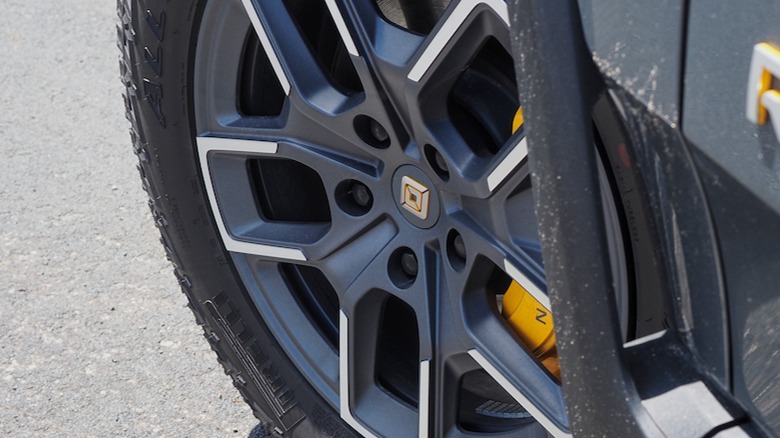 Chris Davies/SlashGear
Chris Davies/SlashGear
Tires make an equally big difference, of course, and there Rivian has a trio of choices. The 20-inch all-terrains are designed to handle off-road use, and as such sacrifice some efficiency; 21-inch road tires with ultra-low rolling resistance should be the range kings. 22-inch sport versions add some more stickiness, for asphalt playtime.
Hustle, if you’re brave enough
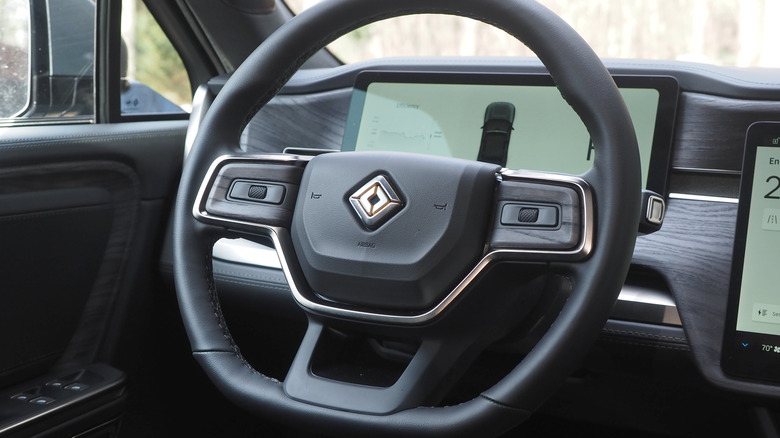
Chris Davies/SlashGear
Despite the drivetrain change, there’s not much noticeable difference between Conserve and All-Purpose mode, at least not on a long stretch of dry highway. That doesn’t mean I didn’t want to leave the R1S in All-Purpose as much as possible (or, for that matter, maximum-potency-unlocking Sport mode).
There’s a reasonable amount of wind and road noise at highway speed, and some rumble through to the steering wheel, though I’m minded to blame the rubber for a large amount of that. Slicker, road-focused tires would undoubtedly be smoother. The flip side is that the air suspension shakes off even Michigan’s burliest potholes, in either the firm or soft modes.
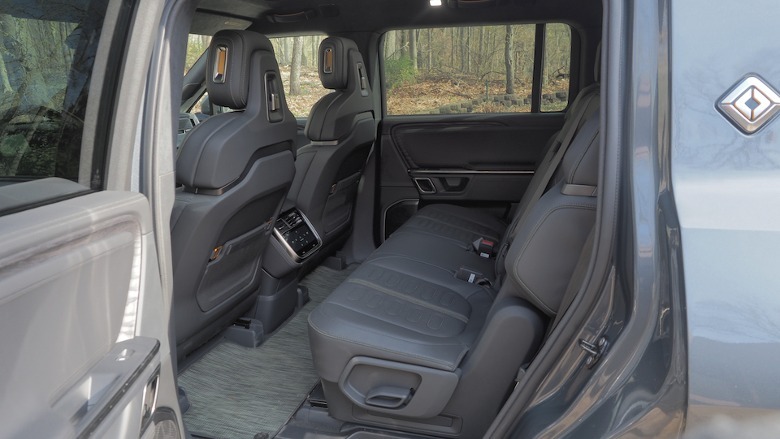 Chris Davies/SlashGear
Chris Davies/SlashGear
This isn’t, despite the potency, a sports car. Or, really, even a sports SUV. You can hustle the R1S and accelerate at borderline-terrifying rates, but physics and the truck’s overall curb weight left me disinclined to test things like its absolute cornering prowess. At least the brakes are more than up to the job, with the blend between regenerative braking — with adjustable levels — and physical anchors being smooth and predictable.
Lots of active safety tech, but it’s not all perfect
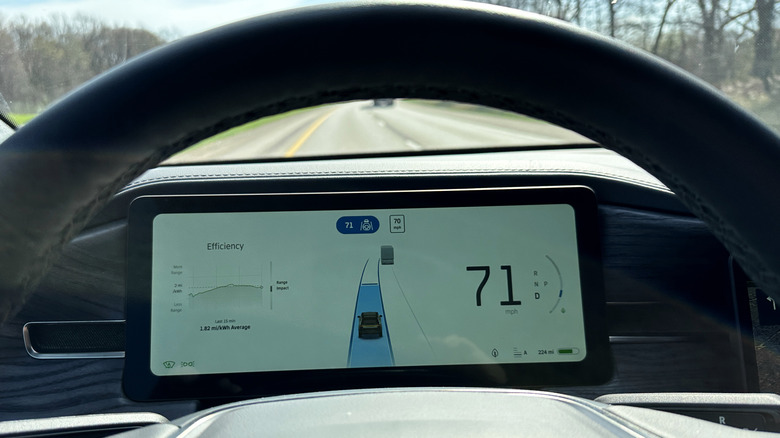
Chris Davies/SlashGear
It’s not an entirely clean sweep, mind. Rivian’s healthy dollop of regen when you’re in reverse can make maneuvers a jerky affair — rival EVs tone down recuperation when they’re backing up, to avoid just that. I got a little smoother the more time I spent behind the wheel, but it’s still annoying.
More frustrating is Rivian’s Highway Assist system. All of the automaker’s cars come with the Driver+ suite, which includes adaptive cruise control, lane-keeping assistance and departure warnings, blind spot warnings, rear cross-traffic alerts, 360-degree parking collision alerts, forward collision warnings, automatic emergency braking, and dynamic brake support. Highway Assist is Rivian’s equivalent to Tesla Autopilot and similar.
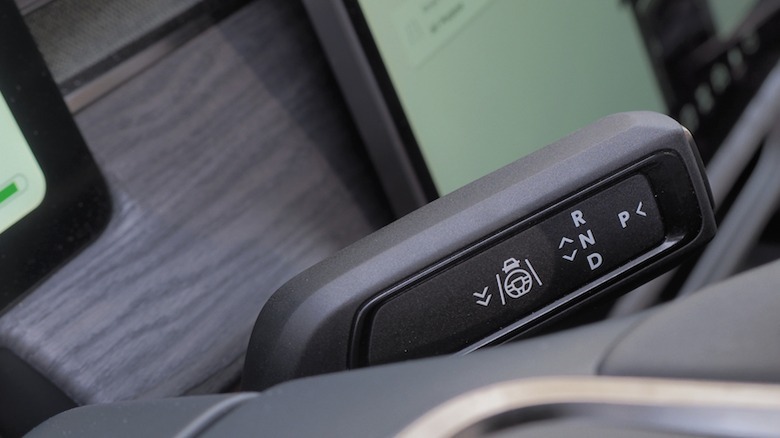 Chris Davies/SlashGear
Chris Davies/SlashGear
In theory, you tap the drive selector stalk down once to enable adaptive cruise, then double-tap it down again to turn on Highway Assist. At that point, a light touch on the sensor-embedded steering wheel should be enough to satisfy the R1S that you’re present and attentive, and the system will take over lane positioning along with acceleration and braking.
OTA updates could patch the gaps
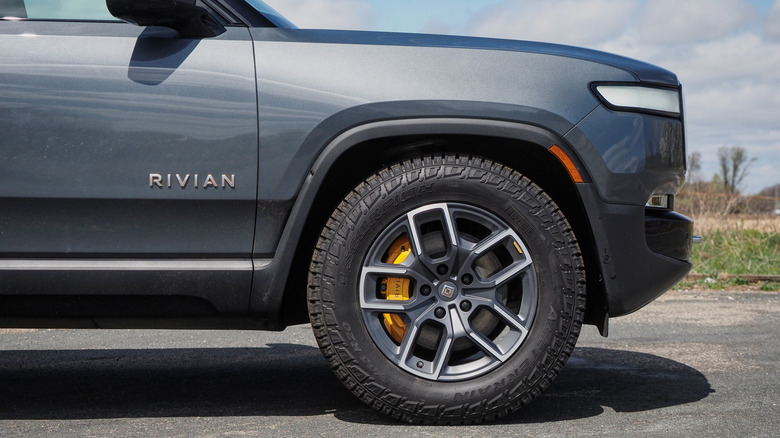
Chris Davies/SlashGear
The reality is that Highway Assist is finicky, and didn’t leave me as confident as rival systems. It dislikes inclement weather — rain was enough to shut the assistance off, though adaptive cruise still worked — and it particularly hates manual steering adjustments, which almost instantly deactivate it. Problem is, the R1S is a wide SUV, and Highway Assist’s lane positioning often left me feeling unduly close to neighboring trucks. I missed Super Cruise and BlueCruise’s intelligent offset within the lane, which biases GM and Ford vehicles so-equipped when alongside another vehicle.
Rivian could — and undoubtedly will — tweak Highway Assist, using the R1S’ over-the-air (OTA) update support. Like the R1T, there’s an embedded 4G LTE modem that can deliver new features and patches. The automaker has already used that to push out things like Camp Mode, which auto-levels the pickup and SUV to make a level surface on uneven terrain, and to improve DC fast charging by bumping the limit up to 500A.
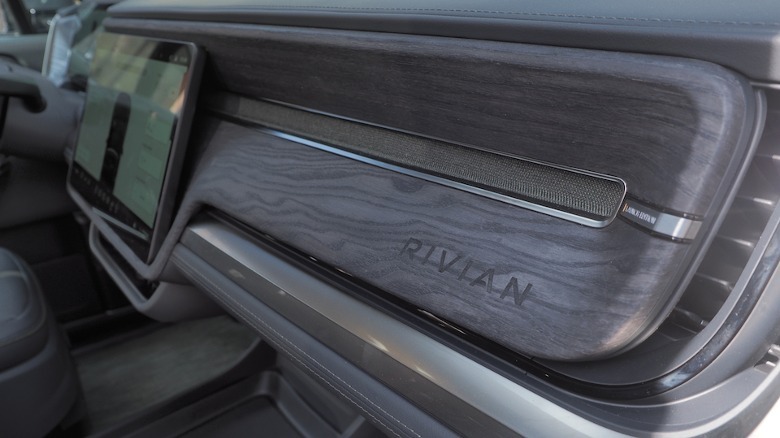 Chris Davies/SlashGear
Chris Davies/SlashGear
I’d love to see Rivian use the same OTA system to add Apple CarPlay and Android Auto to the R1S, which are conspicuous by their absence. Instead, I paired my iPhone via Bluetooth, though I could’ve logged into my Spotify account with the R1S’ native app (there’s also TuneIn and HD radio, though no Apple Music).
Options for charging
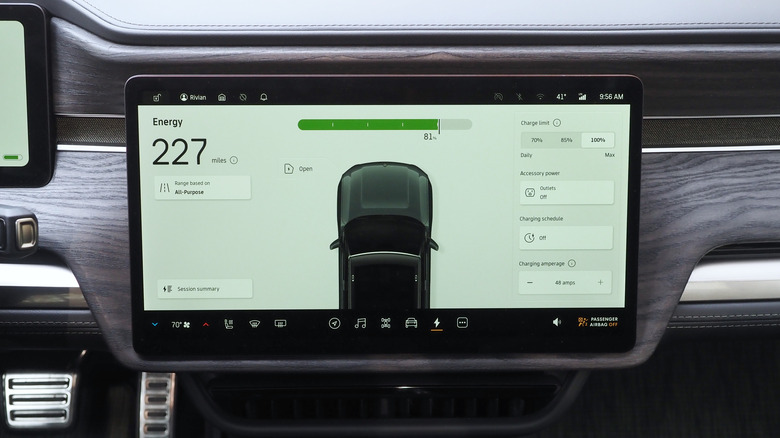
Chris Davies/SlashGear
Big batteries take longer to charge, though the R1S supports DC fast charging at “over 200 kW” rates, according to Rivian. I saw 216 kW at an Electrify America station — the R1S uses the standard CCS connector, so it can take advantage of most public chargers, including Tesla’s small-but-growing number of locations open to non-Tesla EVs — at which point I was adding more than 7 miles of range per minute plugged in.
That’s better than many new EVs manage right now, but it’s the nature of charging to slow as the battery gets fuller. By the time I got to 80% charge, the rate had dropped to under 2 miles of range per minute plugged in. As such, it’s better to wait until your total charge has dropped significantly before stopping; Rivian’s navigation allows filtering of stations by network operator and speed, and can — for some networks — show current availability, too.
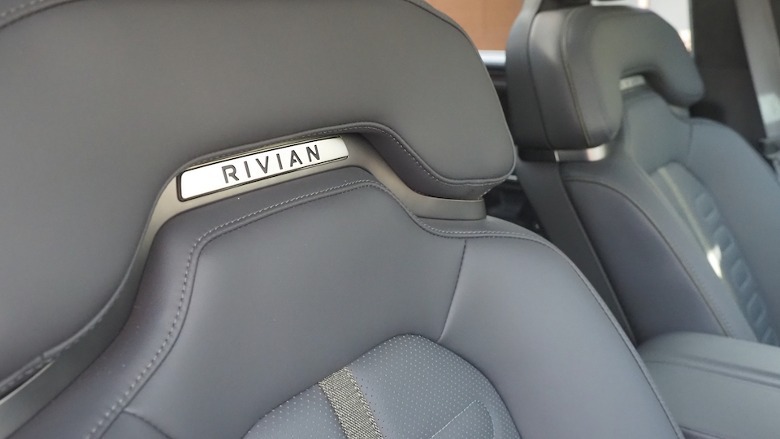 Chris Davies/SlashGear
Chris Davies/SlashGear
Meanwhile, Rivian is in the early stages of building out a charging network of its own. Currently, there’s a relatively small number of locations — though the goal is around 600 within the next two years — but in addition to DC fast chargers in well-trafficked places, the automaker is also putting slower chargers at popular national parks and similar recreational spots.
At home, it’s hard to imagine getting away without a Level 2 charger. Rivian bundles a 240/120V dual voltage portable charger with the EV: plug that into a 240V NEMA 14-50 outlet and you’ll get up to 16 miles of range added per hour plugged in. On a standard 120V outlet, figure on just a few miles per hour.
Rivian R1S Verdict
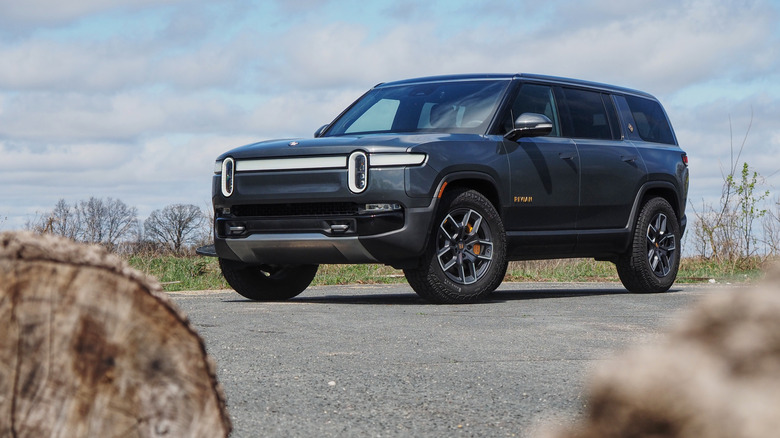
Chris Davies/SlashGear
While I understand the allure of a big, three-row SUV for the American market — and, for that matter, the allure for Rivian of all that wheelbase in which to squeeze a vast battery pack — I can’t help but wish the R1S was a little smaller. Or, more specifically, that there was a two-row SUV that kept the boisterous styling and pleasing cabin, but dropped weight and general heft along with the third row of seats.
Then again, that’s undoubtedly because I don’t have the big family to justify a big SUV, and I’m a little envious of those who can do the math on adding an R1S to their garage. It’s not a perfect EV, but most of my complaints are things Rivian could finesse with fresh software. I’d even willingly sacrifice the quad-motor setup, which though great for bragging rights, is undoubtedly overkill.
As a flagship feature of a flagship SUV for a new brand aiming to carve out a name for itself, I totally understand why that potency is important. However, if rival automakers are going to steal, sorry, borrow anything from the Rivian experience, I hope it’s the attention to detail and personality that the R1S delivers so enthusiastically. It looks and feels special, and it’s more than capable of holding up to traditional luxury players, whether that’s against their EVs or otherwise.


